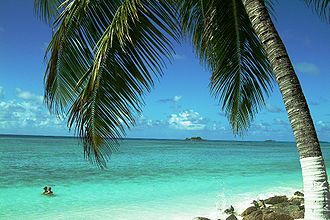Indian Ocean

The Indian Ocean is the third largest of the world's ocean, covering 27,240,000 square miles, including the great gulfs opening into it, with a water volume of 63,000,000 cubic miles, which is approximately 20% of the water on the Earth's surface.[1] It is bounded by Asia on the north, on the west by Africa, on the east by Australia, and on the south by the Southern Ocean or, depending on definition, by Antarctica. For a time, most of the Indian Ocean's coastline was held by the British Empire, in Africa, India, Malaya and Australia, and still much of that coastline belongs to Commonwealth countries.
The British Indian Ocean Territory lies within the Indian Ocean, as its name suggests, covering the scattered isles and atolls of the Chagos Archipelago. The territory has become a naval and military stronghold for defending British and American strategic interests.
Name


The Indian Ocean is named after India, which name in former days was held to encompass not just the subcontinent but the East Indies. It has also been known as the Eastern Ocean (a term still in use during the mid-18th century). To the Greeks, the 'Erythaean Sea', which once described the Red Sea, was extended to the whole ocean beyond.
Oceanography
The Indian Ocean is the warmest ocean in the world. Long-term ocean temperature records show a continuous warming in the Indian Ocean: Indian Ocean warming is the largest among the tropical oceans, and about three times faster than the warming observed in the Pacific.

The average depth of the ocean is 12,762 feet, but there are long ridges through the ocean formed at tectonic plate boundaries and fractures, along which the sea is shallow enough for islands to break the surface; the coral atolls of the Chagos Archipelago are on the Chagos-Laccadive Ridge extending from about 10°S to 15°N. The islands are formed from vast reefs of coral, and their fine sand is again from the coral which has grown in this shallower part of the ocean. The Great Chagos Bank is the largest coral atoll in the world, and alone supports half the total area of good quality reefs in the Indian Ocean. The ring of the atoll is partially submerged but breaks the surface as a series of islands.
The ocean's currents are mainly controlled by the monsoon. Two large gyres, one in the northern hemisphere flowing clockwise and one south of the equator moving anticlockwise (including the Agulhas Current and Agulhas Return Current), constitute the dominant flow pattern. During the winter monsoon (November–February), however, circulation is reversed north of 30°S and winds are weakened during winter and the transitional periods between the monsoons.[2]
Deep water circulation is controlled primarily by inflows from the Atlantic Ocean, the Red Sea, and Antarctic currents. North of the latitude 20° south, the minimum surface temperature is 22 °C (72 °F), exceeding 28 °C (82 °F) to the east. South of 40° south, temperatures drop quickly.
History
Age of Discovery
British ventures on the Indian Ocean began in earnest in the Elizabethan Period. Vasco da Gama of Portugal had rounded the Cape of Good Hope and become the first European to sail to India in 1497, and other followed in the Sixteenth Century. Numerous tales of merchant adventures on the coast of India, the Bay of Bengal and the further coasts of the Ocean are recorded by Hakluyt and others. In 1600, Queen Elizabeth granted a charter to the East India Company, and British merchants began to enter the Ocean in greater numbers, along with those of other nations seeking the wealth of the Indies.
By 1815, Britain become the principal power in the Indian Ocean, and most of its islands were in British hands.
Modern era
The Suez Canal was opened in 1869, the majority share owned by the British government, opening a route from the Mediterranean Sea to the Indian Ocean. The end of empire and the loss of the canal in 1956 reduced British influence, leaving, just Mauritius, the Seychelles and the Chagos Archipelago in British hands, and the former two groups themselves became independent in the 1960s. The United Kingdom and United States maintain a military base on Diego Garcia atoll in the middle of the Indian Ocean.
In the late 2000s the ocean evolved into a hub of pirate activity. By 2013, attacks off the Horn region's coast had steadily declined due to active private security and international navy patrols, especially by the Indian Navy and the Royal Navy.
Outside links
| ("Wikimedia Commons" has material about Indian Ocean) |
References
- ↑ Rais, R.B.: 'The Indian Ocean and the Superpowers' (Routledge, 1986) ISBN 978-0-7099-4241-2; page 33
- ↑ Shankar, D.; Vinayachandran, P. N.; Unnikrishnan, A. S.: 'The monsoon currents in the north Indian Ocean' – Progress in Oceanography Volume 52, Issue 1 (2002); pages 63–120